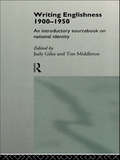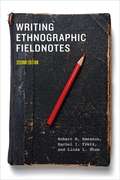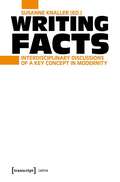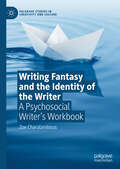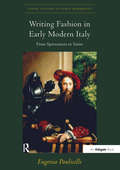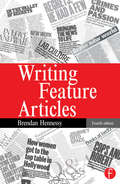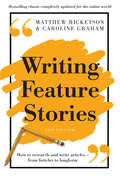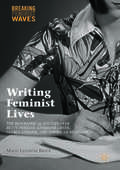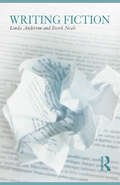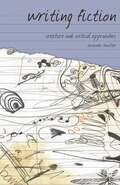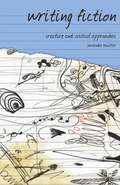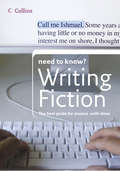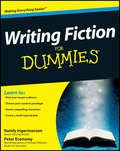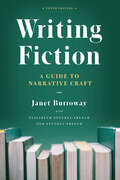- Table View
- List View
Writing Englishness: An Introductory Sourcebook
by Judy Giles Tim MiddletonWhat did it mean in the first half of this century to say `I am English?' A Practical Sourcebook on National Identity is a unique collection of extracts from writing of the era, all of which in some way raise this question. Drawn from a wide range of sources including letters, diaries, journalism, fiction, poems, parliamentary speeches and government reports, the volume is divided into five sections: * The Ideas and Ideals of Englishness * Versions of Rural England * War and National Identity * Culture and Englishness * Domestic and Urban Englands The editors provide an introduction to each section and conclude with suggested study activities and further reading. It also contains a chronology and bibliography, completing the framework for study. A Practical Sourcebook on National Identity is a fascinating collection which will not only be essential and accessible reading for students, but will also appeal to anyone who has ever asked what it means to become part of a national identity.
Writing Englishness: An Introductory Sourcebook
by Judy Giles Tim MiddletonWhat did it mean in the first half of this century to say `I am English?' A Practical Sourcebook on National Identity is a unique collection of extracts from writing of the era, all of which in some way raise this question. Drawn from a wide range of sources including letters, diaries, journalism, fiction, poems, parliamentary speeches and government reports, the volume is divided into five sections: * The Ideas and Ideals of Englishness * Versions of Rural England * War and National Identity * Culture and Englishness * Domestic and Urban Englands The editors provide an introduction to each section and conclude with suggested study activities and further reading. It also contains a chronology and bibliography, completing the framework for study. A Practical Sourcebook on National Identity is a fascinating collection which will not only be essential and accessible reading for students, but will also appeal to anyone who has ever asked what it means to become part of a national identity.
Writing Ethnographic Fieldnotes, Second Edition (Chicago Guides to Writing, Editing, and Publishing)
by Robert M. Emerson Rachel I. Fretz Linda L. ShawIn Writing Ethnographic Fieldnotes, Robert M. Emerson, Rachel I. Fretz, and Linda L. Shaw present a series of guidelines, suggestions, and practical advice for creating useful fieldnotes in a variety of settings, demystifying a process that is often assumed to be intuitive and impossible to teach. Using actual unfinished notes as examples, the authors illustrate options for composing, reviewing, and working fieldnotes into finished texts. They discuss different organizational and descriptive strategies and show how transforming direct observations into vivid descriptions results not simply from good memory but from learning to envision scenes as written. A good ethnographer, they demonstrate, must learn to remember dialogue and movement like an actor, to see colors and shapes like a painter, and to sense moods and rhythms like a poet. This new edition reflects the extensive feedback the authors have received from students and instructors since the first edition was published in 1995. As a result, they have updated the race, class, and gender section, created new sections on coding programs and revising first drafts, and provided new examples of working notes. An essential tool for budding social scientists, the second edition of Writing Ethnographic Fieldnotes will be invaluable for a new generation of researchers entering the field.
Writing Ethnographic Fieldnotes, Second Edition (Chicago Guides to Writing, Editing, and Publishing)
by Robert M. Emerson Rachel I. Fretz Linda L. ShawIn Writing Ethnographic Fieldnotes, Robert M. Emerson, Rachel I. Fretz, and Linda L. Shaw present a series of guidelines, suggestions, and practical advice for creating useful fieldnotes in a variety of settings, demystifying a process that is often assumed to be intuitive and impossible to teach. Using actual unfinished notes as examples, the authors illustrate options for composing, reviewing, and working fieldnotes into finished texts. They discuss different organizational and descriptive strategies and show how transforming direct observations into vivid descriptions results not simply from good memory but from learning to envision scenes as written. A good ethnographer, they demonstrate, must learn to remember dialogue and movement like an actor, to see colors and shapes like a painter, and to sense moods and rhythms like a poet. This new edition reflects the extensive feedback the authors have received from students and instructors since the first edition was published in 1995. As a result, they have updated the race, class, and gender section, created new sections on coding programs and revising first drafts, and provided new examples of working notes. An essential tool for budding social scientists, the second edition of Writing Ethnographic Fieldnotes will be invaluable for a new generation of researchers entering the field.
Writing Ethnographic Fieldnotes, Second Edition (Chicago Guides to Writing, Editing, and Publishing)
by Robert M. Emerson Rachel I. Fretz Linda L. ShawIn Writing Ethnographic Fieldnotes, Robert M. Emerson, Rachel I. Fretz, and Linda L. Shaw present a series of guidelines, suggestions, and practical advice for creating useful fieldnotes in a variety of settings, demystifying a process that is often assumed to be intuitive and impossible to teach. Using actual unfinished notes as examples, the authors illustrate options for composing, reviewing, and working fieldnotes into finished texts. They discuss different organizational and descriptive strategies and show how transforming direct observations into vivid descriptions results not simply from good memory but from learning to envision scenes as written. A good ethnographer, they demonstrate, must learn to remember dialogue and movement like an actor, to see colors and shapes like a painter, and to sense moods and rhythms like a poet. This new edition reflects the extensive feedback the authors have received from students and instructors since the first edition was published in 1995. As a result, they have updated the race, class, and gender section, created new sections on coding programs and revising first drafts, and provided new examples of working notes. An essential tool for budding social scientists, the second edition of Writing Ethnographic Fieldnotes will be invaluable for a new generation of researchers entering the field.
Writing Ethnographic Fieldnotes, Second Edition (Chicago Guides to Writing, Editing, and Publishing)
by Robert M. Emerson Rachel I. Fretz Linda L. ShawIn Writing Ethnographic Fieldnotes, Robert M. Emerson, Rachel I. Fretz, and Linda L. Shaw present a series of guidelines, suggestions, and practical advice for creating useful fieldnotes in a variety of settings, demystifying a process that is often assumed to be intuitive and impossible to teach. Using actual unfinished notes as examples, the authors illustrate options for composing, reviewing, and working fieldnotes into finished texts. They discuss different organizational and descriptive strategies and show how transforming direct observations into vivid descriptions results not simply from good memory but from learning to envision scenes as written. A good ethnographer, they demonstrate, must learn to remember dialogue and movement like an actor, to see colors and shapes like a painter, and to sense moods and rhythms like a poet. This new edition reflects the extensive feedback the authors have received from students and instructors since the first edition was published in 1995. As a result, they have updated the race, class, and gender section, created new sections on coding programs and revising first drafts, and provided new examples of working notes. An essential tool for budding social scientists, the second edition of Writing Ethnographic Fieldnotes will be invaluable for a new generation of researchers entering the field.
Writing Facts: Interdisciplinary Discussions of a Key Concept in Modernity (Lettre)
by Susanne Knaller»Fact« is one of the most crucial inventions of modern times. Susanne Knaller discusses the functions of this powerful notion in the arts and the sciences, its impact on aesthetic models and systems of knowledge. The practice of writing provides an effective procedure to realize and to understand facts. This concerns preparatory procedures, formal choices, models of argumentation, and narrative patterns. By considering »writing facts« and »writing facts«, the volume shows why and how »facts« are a result of knowledge, rules, and norms as well as of description, argumentation, and narration. This approach allows new perspectives on »fact« and its impact on modernity.
Writing Fantasy and the Identity of the Writer: A Psychosocial Writer’s Workbook (Palgrave Studies in Creativity and Culture)
by Zoe CharalambousThis book presents the innovative pedagogy of Writing Fantasy: a method for exploring and shifting one’s identity as a writer. The book draws on qualitative research with undergraduate creative writing students and fills a gap in the literature exploring creative writing pedagogy and creative writing exercises. Based on the potential to shift writer identity through creative writing exercises and the common ground that these share with the stance of the Lacanian analyst, the author provides a set of guidelines, exercises and case studies to trace writing fantasy, evidenced in one’s creative writing texts and responses about creative writing. This innovative work offers fresh insights for scholars of creativity, Lacan and psychosocial studies, and a valuable new resource for students and teachers of creative writing.
Writing Fashion in Early Modern Italy: From Sprezzatura to Satire (Visual Culture in Early Modernity)
by Eugenia PaulicelliThe first comprehensive study on the role of Italian fashion and Italian literature, this book analyzes clothing and fashion as described and represented in literary texts and costume books in the Italy of the 16th and 17th centuries. Writing Fashion in Early Modern Italy emphasizes the centrality of Italian literature and culture for understanding modern theories of fashion and gauging its impact in the shaping of codes of civility and taste in Europe and the West. Using literature to uncover what has been called the ’animatedness of clothing,’ author Eugenia Paulicelli explores the political meanings that clothing produces in public space. At the core of the book is the idea that the texts examined here act as maps that, first, pinpoint the establishment of fashion as a social institution of modernity; and, second, gauge the meaning of clothing at a personal and a political level. As well as Castiglione’s The Book of the Courtier and Cesare Vecellio’s The Clothing of the Renaissance World, the author looks at works by Italian writers whose books are not yet available in English translation, such as those by Giacomo Franco, Arcangela Tarabotti, and Agostino Lampugnani. Paying particular attention to literature and the relevance of clothing in the shaping of codes of civility and style, this volume complements the existing and important works on Italian fashion and material culture in the Renaissance. It makes the case for the centrality of Italian literature and the interconnectedness of texts from a variety of genres for an understanding of the history of Italian style, and serves to contextualize the debate on dress in other European literatures.
Writing Fashion in Early Modern Italy: From Sprezzatura to Satire (Visual Culture in Early Modernity)
by Eugenia PaulicelliThe first comprehensive study on the role of Italian fashion and Italian literature, this book analyzes clothing and fashion as described and represented in literary texts and costume books in the Italy of the 16th and 17th centuries. Writing Fashion in Early Modern Italy emphasizes the centrality of Italian literature and culture for understanding modern theories of fashion and gauging its impact in the shaping of codes of civility and taste in Europe and the West. Using literature to uncover what has been called the ’animatedness of clothing,’ author Eugenia Paulicelli explores the political meanings that clothing produces in public space. At the core of the book is the idea that the texts examined here act as maps that, first, pinpoint the establishment of fashion as a social institution of modernity; and, second, gauge the meaning of clothing at a personal and a political level. As well as Castiglione’s The Book of the Courtier and Cesare Vecellio’s The Clothing of the Renaissance World, the author looks at works by Italian writers whose books are not yet available in English translation, such as those by Giacomo Franco, Arcangela Tarabotti, and Agostino Lampugnani. Paying particular attention to literature and the relevance of clothing in the shaping of codes of civility and style, this volume complements the existing and important works on Italian fashion and material culture in the Renaissance. It makes the case for the centrality of Italian literature and the interconnectedness of texts from a variety of genres for an understanding of the history of Italian style, and serves to contextualize the debate on dress in other European literatures.
Writing Feature Articles
by Brendan HennessyHennessy's classic text tells you everything you need to know about writing successful features. You will learn how to formulate and develop ideas and how to shape them to fit different markets. Now in its fourth edition, Writing Feature Articles has been fully revised and updated to take into account the changing requirements of journalism and media courses. You will also discover how to exploit new technology for both researching and writing online.Learn step-by-step how to plan, research and write articles for a wide variety of 'popular', 'quality' and specialist publications. Discover more and make the advice stick by completing the tasks and reading the keen analysis of extracts from the best of today's writing.Packed with inspirational advice in a friendly, highly readable style, this guide is a must-have for practising and aspiring journalists and writers.
Writing Feature Articles
by Brendan HennessyHennessy's classic text tells you everything you need to know about writing successful features. You will learn how to formulate and develop ideas and how to shape them to fit different markets. Now in its fourth edition, Writing Feature Articles has been fully revised and updated to take into account the changing requirements of journalism and media courses. You will also discover how to exploit new technology for both researching and writing online.Learn step-by-step how to plan, research and write articles for a wide variety of 'popular', 'quality' and specialist publications. Discover more and make the advice stick by completing the tasks and reading the keen analysis of extracts from the best of today's writing.Packed with inspirational advice in a friendly, highly readable style, this guide is a must-have for practising and aspiring journalists and writers.
Writing Feature Stories: How to research and write articles - from listicles to longform
by Matthew Ricketson Caroline GrahamGood writing engages as it informs and feature journalism offers writers the opportunity to tell deep, affecting stories that look beyond the immediate mechanics of who, what, where and when and explore the more difficult-and more rewarding- questions: how and why? Whether you're a blogger, a news journalist or an aspiring lifestyle reporter, a strong voice and a fresh, informed perspective remain in short supply and strong demand; this book will help you craft the kind of narratives people can't wait to share on their social media feeds.Writing Feature Stories established a reputation as a comprehensive, thought-provoking and engaging introduction to researching and writing feature stories. This second edition is completely overhauled to reflect the range of print and digital feature formats, and the variety of online, mobile and traditional media in which they appear.This hands-on guide explains how to generate fresh ideas; research online and offline; make the most of interviews; sift and sort raw material; structure and write the story; edit and proofread your work; find the best platform for your story; and pitch your work to editors.'A wide-ranging, much-needed master class for anyone who tells true yarns in this fast-changing journalistic marketplace' - Bruce Shapiro, Columbia University'Useful and thought provoking' - Margaret Simons, journalist and author'A must read for any digital storyteller who wants to write emotive, engaging, believable content.' - Nidhi Dutt, foreign correspondent
Writing Feature Stories: How to research and write articles - from listicles to longform
by Matthew Ricketson Caroline GrahamGood writing engages as it informs and feature journalism offers writers the opportunity to tell deep, affecting stories that look beyond the immediate mechanics of who, what, where and when and explore the more difficult-and more rewarding- questions: how and why? Whether you're a blogger, a news journalist or an aspiring lifestyle reporter, a strong voice and a fresh, informed perspective remain in short supply and strong demand; this book will help you craft the kind of narratives people can't wait to share on their social media feeds.Writing Feature Stories established a reputation as a comprehensive, thought-provoking and engaging introduction to researching and writing feature stories. This second edition is completely overhauled to reflect the range of print and digital feature formats, and the variety of online, mobile and traditional media in which they appear.This hands-on guide explains how to generate fresh ideas; research online and offline; make the most of interviews; sift and sort raw material; structure and write the story; edit and proofread your work; find the best platform for your story; and pitch your work to editors.'A wide-ranging, much-needed master class for anyone who tells true yarns in this fast-changing journalistic marketplace' - Bruce Shapiro, Columbia University'Useful and thought provoking' - Margaret Simons, journalist and author'A must read for any digital storyteller who wants to write emotive, engaging, believable content.' - Nidhi Dutt, foreign correspondent
Writing Feminist Lives: The Biographical Battles over Betty Friedan, Germaine Greer, Gloria Steinem, and Simone de Beauvoir (Breaking Feminist Waves)
by Malin Lidström BrockThis book draws attention to the controversy that surrounds Betty Friedan, Germaine Greer, Gloria Steinem, and Simone de Beauvoir’s lives and the important role that their life stories have played in their feminist writing. Directly and indirectly, the four women have contributed to battles over feminism’s meaning through autobiographically informed political writing. Inevitably, therefore, their biographers are also participants in these battles, yet not always on the same side as their subjects. Writing Feminist Lives introduces a further fold of nuance into considerations of biography and feminism by showing that the biographers of the four women have made methodological choices that reflect their loyalty to, or their scepticism towards, competing ideological definitions of the exemplary feminist life.
Writing Fiction
by Linda Anderson Derek NealeWriting Fiction offers the novice writer engaging and creative activities, making use of insightful, relevant readings from well-known authors to illustrate the techniques presented. This volume makes use of new versions of key chapters from the recent Routledge/Open University textbook Creative Writing: A Workbook with Readings for writers who are specializing in fiction. Using their experience and expertise as teachers as well as authors, Linda Anderson and Derek Neale guide aspiring writers through such key aspects of writing as: how to stimulate creativity keeping a writer’s notebook character creation setting point of view structure showing and telling. The volume is further updated to include never-before published interviews with successful fiction writers Andrew Cowan, Stevie Davies, Maggie Gee, Andrew Greig, and Hanif Kureishi. Concise and practical, Writing Fiction offers an inspirational guide to the methods and techniques of authorship and is a must-read for aspiring writers.
Writing Fiction
by Linda Anderson Derek NealeWriting Fiction offers the novice writer engaging and creative activities, making use of insightful, relevant readings from well-known authors to illustrate the techniques presented. This volume makes use of new versions of key chapters from the recent Routledge/Open University textbook Creative Writing: A Workbook with Readings for writers who are specializing in fiction. Using their experience and expertise as teachers as well as authors, Linda Anderson and Derek Neale guide aspiring writers through such key aspects of writing as: how to stimulate creativity keeping a writer’s notebook character creation setting point of view structure showing and telling. The volume is further updated to include never-before published interviews with successful fiction writers Andrew Cowan, Stevie Davies, Maggie Gee, Andrew Greig, and Hanif Kureishi. Concise and practical, Writing Fiction offers an inspirational guide to the methods and techniques of authorship and is a must-read for aspiring writers.
Writing Fiction: Creative and Critical Approaches (Approaches to Writing)
by Amanda BoulterExploring writing as a practice, Boulter draws from the work of writers and theorists to show how cultural and literary debates can help writers enhance their own fiction. Negotiating the creative-critical crossover, this is an approachable book that helps students develop practical writing skills and a critical awareness of creative possibilities.
Writing Fiction: Creative and Critical Approaches (Approaches to Writing)
by Amanda BoulterExploring writing as a practice, Boulter draws from the work of writers and theorists to show how cultural and literary debates can help writers enhance their own fiction. Negotiating the creative-critical crossover, this is an approachable book that helps students develop practical writing skills and a critical awareness of creative possibilities.
Writing Fiction: Creative and Critical Approaches (PDF)
by Amanda Boulter Graeme HarperExploring writing as a practice, Boulter draws from the work of writers and theorists to show how cultural and literary debates can help writers enhance their own fiction. Negotiating the creative-critical crossover, this is an approachable book that helps students develop practical writing skills and a critical awareness of creative possibilities.
Writing Fiction (Collins Need to Know?)
by Alan WallThis one-stop practical guide will show you how to write the novel that’s in you bursting to get out. To make your progress easier, it comes in a handy ebook format with expert advice throughout.
Writing Fiction For Dummies: A Science Fiction Suspense Novel
by Randy Ingermanson Peter EconomyA complete guide to writing and selling your novel So you want to write a novel? Great! That’s a worthy goal, no matter what your reason. But don’t settle for just writing a novel. Aim high. Write a novel that you intend to sell to a publisher. Writing Fiction for Dummies is a complete guide designed to coach you every step along the path from beginning writer to royalty-earning author. Here are some things you’ll learn in Writing Fiction for Dummies: Strategic Planning: Pinpoint where you are on the roadmap to publication; discover what every reader desperately wants from a story; home in on a marketable category; choose from among the four most common creative styles; and learn the self-management methods of professional writers. Writing Powerful Fiction: Construct a story world that rings true; create believable, unpredictable characters; build a strong plot with all six layers of complexity of a modern novel; and infuse it all with a strong theme. Self-Editing Your Novel: Psychoanalyze your characters to bring them fully to life; edit your story structure from the top down; fix broken scenes; and polish your action and dialogue. Finding An Agent and Getting Published: Write a query letter, a synopsis, and a proposal; pitch your work to agents and editors without fear. Writing Fiction For Dummies takes you from being a writer to being an author. It can happen—if you have the talent and persistence to do what you need to do.
Writing Fiction For Dummies
by Randy Ingermanson Peter EconomyA complete guide to writing and selling your novel So you want to write a novel? Great! That’s a worthy goal, no matter what your reason. But don’t settle for just writing a novel. Aim high. Write a novel that you intend to sell to a publisher. Writing Fiction for Dummies is a complete guide designed to coach you every step along the path from beginning writer to royalty-earning author. Here are some things you’ll learn in Writing Fiction for Dummies: Strategic Planning: Pinpoint where you are on the roadmap to publication; discover what every reader desperately wants from a story; home in on a marketable category; choose from among the four most common creative styles; and learn the self-management methods of professional writers. Writing Powerful Fiction: Construct a story world that rings true; create believable, unpredictable characters; build a strong plot with all six layers of complexity of a modern novel; and infuse it all with a strong theme. Self-Editing Your Novel: Psychoanalyze your characters to bring them fully to life; edit your story structure from the top down; fix broken scenes; and polish your action and dialogue. Finding An Agent and Getting Published: Write a query letter, a synopsis, and a proposal; pitch your work to agents and editors without fear. Writing Fiction For Dummies takes you from being a writer to being an author. It can happen—if you have the talent and persistence to do what you need to do.
Writing Fiction, Tenth Edition: A Guide to Narrative Craft (Chicago Guides to Writing, Editing, and Publishing)
by Janet Burroway Elizabeth Stuckey-French Ned Stuckey-FrenchMore than 250,000 copies sold! A creative writer’s shelf should hold at least three essential books: a dictionary, a style guide, and Writing Fiction. Janet Burroway’s best-selling classic is the most widely used creative writing text in America, and for more than three decades it has helped hundreds of thousands of students learn the craft. Now in its tenth edition, Writing Fiction is more accessible than ever for writers of all levels—inside or outside the classroom. This new edition continues to provide advice that is practical, comprehensive, and flexible. Burroway’s tone is personal and nonprescriptive, welcoming learning writers into the community of practiced storytellers. Moving from freewriting to final revision, the book addresses “showing not telling,” characterization, dialogue, atmosphere, plot, imagery, and point of view. It includes new topics and writing prompts, and each chapter now ends with a list of recommended readings that exemplify the craft elements discussed, allowing for further study. And the examples and quotations throughout the book feature a wide and diverse range of today’s best and best-known creators of both novels and short stories. This book is a master class in creative writing that also calls on us to renew our love of storytelling and celebrate the skill of writing well. There is a very good chance that one of your favorite authors learned the craft with Writing Fiction. And who knows what future favorite will get her start reading this edition?
Writing Fiction, Tenth Edition: A Guide to Narrative Craft (Chicago Guides to Writing, Editing, and Publishing)
by Janet Burroway Elizabeth Stuckey-French Ned Stuckey-FrenchMore than 250,000 copies sold! A creative writer’s shelf should hold at least three essential books: a dictionary, a style guide, and Writing Fiction. Janet Burroway’s best-selling classic is the most widely used creative writing text in America, and for more than three decades it has helped hundreds of thousands of students learn the craft. Now in its tenth edition, Writing Fiction is more accessible than ever for writers of all levels—inside or outside the classroom. This new edition continues to provide advice that is practical, comprehensive, and flexible. Burroway’s tone is personal and nonprescriptive, welcoming learning writers into the community of practiced storytellers. Moving from freewriting to final revision, the book addresses “showing not telling,” characterization, dialogue, atmosphere, plot, imagery, and point of view. It includes new topics and writing prompts, and each chapter now ends with a list of recommended readings that exemplify the craft elements discussed, allowing for further study. And the examples and quotations throughout the book feature a wide and diverse range of today’s best and best-known creators of both novels and short stories. This book is a master class in creative writing that also calls on us to renew our love of storytelling and celebrate the skill of writing well. There is a very good chance that one of your favorite authors learned the craft with Writing Fiction. And who knows what future favorite will get her start reading this edition?
